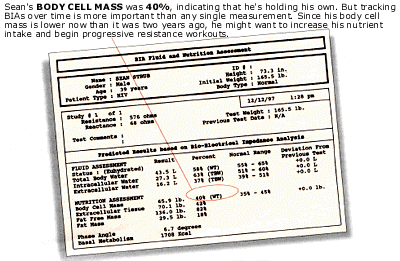Lab analyses of blood and other medical measurements, which help health practitioners make diagnoses and detect toxic effects of medication, can also help people with HIV track their health. Norma Muurahainen, MD, PhD, is a nationally recognized expert on HIV nutrition and wasting, areas in which she has conducted many clinical trials. (Since writing this article, she has become medical director of metabolic and immune therapies at Serono Laboratories, manufacturer of the recombinant human growth hormone Serostim.) Muurahainen analyzes the results of POZ founder Sean O. Strub’s most recent bioelectrical impedance analysis.

To assess how well Sean is doing in preventing internal decline and wasting, he recently underwent his third bioelectrical impedance analysis (BIA). The BIA is a very important tool for measuring body cell mass, the metabolically important tissue contained in your muscles and organs. The loss of body cell mass is a clear indicator of wasting and has been strongly tied to disease progression. In fact, loss of body cell mass has been shown to be a strong predictor of death. Unfortunately, too many physicians still base their assessments of the presence of wasting on measurements of weight alone. German researchers have shown that weight may not change significantly -- especially in the earlier stages of wasting -- and so the loss of muscle and organ tissue that can ultimately lead to death may not be noticed unless a BIA is performed.
This relatively inexpensive measurement (usually $40-$60 and reimbursable through standard insurance and Medicaid) is done with a device that uses a painless electric current to measure body composition. The test is simple, requiring only that the patient lie down with two adhesive electrodes attached to a foot and two others attached to a hand on the same side. Then the machine sends a signal from one set of electrodes to the other. The higher the percentage of body cell mass in the body, the faster the signal will travel. This is because cells contain about 70 percent water, a good conductor of electricity. Fat, being only 5 to 13 percent water, is not and so will “impede” the signal. From the machine’s readings, it is possible to estimate the percentages of the body that are fat, body cell mass and water. Values obtained by BIA can be compared to a reference group of equivalent gender, race, age, height, weight and/or a person’s previous measurement. With the more sophisticated machines, an attached computer generates an immediate report; others give numbers that are later interpreted with a computer program.
My recommendation is that every single HIV positive person have a baseline BIA measurement performed, and then be monitored over time so that significant alterations in the measurements will be quickly noticed. For those with CD4 counts above 300, follow-up measurements should be taken every four to six months. For those with counts below 300, at least quarterly measurements should be taken. It is also advisable to have BIA measurements taken during and after any infection or whenever there is measurable weight loss or observable changes in muscle mass or body shape. At such times, one may rapidly lose significant body cell mass. Doing BIAs could be lifesaving since they could indicate loss of body cell mass before it becomes life-threatening, thus allowing for the rapid implementation of all the measures necessary to reverse it. When the BIA shows significant loss of body cell mass, it would be appropriate to consider using anabolic therapies such as testosterone, nandrolone, oxandrolone or human growth hormone in conjunction with good nutrition, exercise and optimal antiretroviral therapy.
The printout provided with the BIA will vary, depending on the computer program used with it, but will usually list a number of different readings, including, with some machines, reference ranges based on your personal characteristics. Ideally, you will be “normal” for someone with your characteristics (weight, sex, age and so on). For example, body cell mass (BCM) is calculated from weight and the BIA readings. The average normal ranges for BCM are 35 to 45 percent for men and 30 to 40 percent for women, but you simply need to be “normal” for your weight. The best outcome would be to match the “ideal body cell mass.” If you’re dropping below that, you’re losing ground. Sean’s body cell mass was 40%, indicating that he’s currently in a safe place (the normal range is 35%-45%). He’s improved a bit on this crucial measurement since last tested in April 1997, when his BCM was 37 percent, but it’s down a bit from his 42 percent reading in December 1995 (see "Waste Management," POZ, February/ March 1996). Over that same period, which roughly coincides with his introduction of combination therapy and KS treatment, his weight has fluctuated from 155 pounds in 1995 to 173 in April 1997 to 165.5 in the most recent measure.
Both the body cell mass and the extracellular mass (ECM) are measured in pounds or kilograms. While not listed on Sean’s report, the ratio of the ECM (referred to here as extracellular tissue) to the BCM -- often included on BIA reports as the ECM/BCM ratio -- should be more than 1. Sean’s ratio, calculated by dividing the ECM by the BCM, was 1.3. The fat free mass (often called lean body mass -- all body components except stored fat) is also calculated. Again, the ideal is to be “normal.” Sean’s fat free mass was 82%. Although the normal range isn’t shown on his lab printout, this reading indicates good body composition.
Sean’s phase angle was 6.7. This is a mathematically calculated value that normally averages more than 5 in healthy people. The significance of small changes in this measurement is unclear. Very low phase angles have been correlated with increased mortality in PWAs, but whether smaller changes really tell us anything useful about either nutritional status or disease progression has yet to be determined.
The BIA also shows how well-hydrated you are and whether your cells are “leaking” water. In terms of total body water, Sean is within the normal range of 55%?65%. For intracellular water, the normal range is 51%-60%, but being slightly high, as Sean is at 63%, is actually good since it means your cells aren’t leaking; your muscles are holding water. The normal range for extracellular water is 39%-51%, but being slightly low, as Sean is at 37%, is actually good (for the same reason). Overall, euhydrated, as Sean is found to be, is good, and dehydrated is bad.
Substantial overhydration may reflect problems in the kidneys, liver or heart and deserve further medical evaluation. Dehydration can be secondary to fever, diarrhea or inadequate fluid intake and generally warrants fluid and electrolyte replacement.
Overall, these readings tell us that Sean is in good shape. Since he’s lost considerable weight in the past, this is a clear indicator that he has benefited from the combination of a potent antiretroviral program with oxandrolone (a muscle-building anabolic steroid), Marinol (used when needed as an appetite stimulant), good nutrition and exercise.
However, we must never forget that tracking BIAs over time is more important than any single measurement. The fact that Sean’s body cell mass is now somewhat lower than two years ago might prompt him to increase his nutrient intake and begin progressive resistance workouts. He should also monitor his testosterone level so that he can replenish it, if needed. Regularly scheduled follow-up BIAs -- at least one per quarter -- will be very important to see if his body cell mass stabilizes after he makes such changes.
Already available in many large hospitals and clinics, it is very important that physicians treating PWAs obtain BIA machines for their offices so that BIA measurements can become a standard part of every office visit. The instrument preferred by most researchers is the RJL machine, which uses equations validated specifically for PWAs by wasting expert Donald Kotler, MD, and his colleagues at Columbia University.
Because bioelectrical impedance is very sensitive, for the best results it is important to make sure your water and caffeine intake are the same on each occasion. Because a change in the water level in your body can alter the results (the more dehydrated you are, the more the machine will overestimate your body fat), it is best to avoid both caffeine and alcohol (both cause fluid loss) for 24 to 48 hours prior to a BIA. In addition, it is preferable that the BIA always be done at the same time of day, without eating or exercising enough to sweat for three hours prior. (Ideally, vigorous exercise should be avoided for the preceding 24 hours.) To get accurately comparable measurements, the best time of day for a BIA is first thing in the morning, before any meals or caffeine or exercise, and after emptying the bladder.
By making BIAs a regular part of a PWA’s workup, we can help ensure that the early signs of wasting are caught in plenty of time to do everything necessary to stay vigorous and prevent illness and death.






Comments
Comments